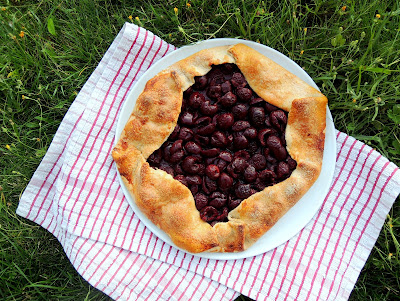Choosing a favourite fruit rather feels like choosing a favourite child - is it the first bite of a crisp russet in October; a juicy Clementine at Christmas; a slice of watermelon on a summer's afternoon or a pale pink stalk of rhubarb brightening the late winter gloom? While my mind changes as quickly as the seasons, if push were really to come to shove, I think it would have to be the English cherry. The fact that they are still only available during the late summer makes them taste even sweeter for those few blissful weeks where I’m never far from a brown paper bag full of the little red fruit.
One dark moment came a few years ago when, after preparing dinner, I sat down to greedily munch my way through a pound or two. On eating the first few, my lips began to tingle and burn - immediately I thought of my mother who, at about the same age as I then was, had developed an allergy to cherries whilst eating them on a picnic in France. Suddenly, a grim stone fruit free future loomed, at least until I pieced together the evidence and realised the unpleasant burning sensation was related to the fact I had been previously chopping fresh chillies, and, thankfully, had nothing to do with the cherries at all.
I have always studiously avoided using fresh cherries in recipes; primarily because there just perfect eaten as they are, but also because of the lack of a cherry pitter in my life. This summer, having bought a crate of local cherries large enough that even I had trouble finishing them, I decided to finally make the leap and buy one to make Delia Smiths one crust fruit pie, from her peerless Summer Collection.
Suffice to say, the pitter lasted about four minutes - just the time it took to realise the time spent saved pitting the cherries would be spent wiping spurts of cherry juice from the walls/floors/cupboards/my eyes...
Eagle-eyed readers may have also noticed the quote marks around the ‘easy’ in the title of this blog; if the cherry pitter wasn't enught of a pitfall, I still had to make the pastry. While I set out to attempt it in a bullish frame of mind, reasoning if Delia said it was simple then surely it must be, my first effort ended up crumbling onto the floor, into the cat’s bowl, on the bottom of my shoes and, finally, into the bin. The situation, as now seems customary with anything involving pastry making in our house, quickly descended into a row, with the Ewing’s attempts to help lift the dough onto the baking sheet also ending in an unmitigated disaster.
With the Ewing safely upstairs sulking, I persevered with a second batch, this time using the trusty food processor rather than by hand. While this second attempt had the opposite problem of being rather too wet, as opposed to resembling sand, it was, thankfully, far easier to roll out.
After the bitter and bloody battle that proceeded it, the pie turned out to be a hard won success. Especially when served served warm, in thick slices with plenty of vanilla ice cream.
After the bitter and bloody battle that proceeded it, the pie turned out to be a hard won success. Especially when served served warm, in thick slices with plenty of vanilla ice cream.
One Crust Cherry Pie with Hazelnut Pastry
Adapted from Delia's Summer Collection
For the filling
700 g pitted cherries
40g caster sugar
2 tbsp semolina/polenta
1 egg yolk
For the glaze
1 egg white
For the shortcrust pastry:
175 g plain flour
50g ground hazelnuts
80 g butter
1/2 tsp ground cinnamon
Make up the pastry by sifting the flour into a large mixing bowl, then rubbing the fats into it lightly with your fingertips.
When the mixture reaches the crumb stage, sprinkle in enough cold water to bring it together to a smooth dough that leaves the bowl absolutely clean.
Give it a little light knead to bring it fully together, then place the pastry in a polythene bag in the fridge for 30 minutes.
Pre-heat the oven to gas mark 6, 400°F (200°C).
Then roll the pastry out on a flat surface to a round of approximately 35 cm as you roll, ragged edges are fine.
Carefully roll the pastry round the rolling pin and transfer it to the centre of the lightly greased baking sheet.
To prevent the pastry getting soggy from any excess juice, paint the base with egg yolk, then sprinkle the semolina lightly over to soak up the juices from the fruit.
No turn in the edges of the pastry: if any breaks, just patch it back on again.
Brush the pastry surface all round with the beaten egg white .
Place highest shelf of the oven and bake for approximately 35 minutes or until the crust is golden brown.





